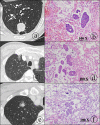The correlation between tumor radiological features and spread through air spaces in peripheral stage IA lung adenocarcinoma: a propensity score-matched analysis
- PMID: 38263158
- PMCID: PMC10804508
- DOI: 10.1186/s13019-024-02498-0
The correlation between tumor radiological features and spread through air spaces in peripheral stage IA lung adenocarcinoma: a propensity score-matched analysis
Abstract
Background: The consolidation tumor ratio (CTR) is a predictor of invasiveness in peripheral T1N0M0 lung adenocarcinoma. However, its association with spread through air spaces (STAS) remains largely unexplored. We aimed to explore the correlation between the CTR of primary tumors and STAS in peripheral T1N0M0 lung adenocarcinoma.
Methods: We collected data from patients who underwent surgery for malignant lung neoplasms between January and November 2022. Univariate and multivariate analyses following propensity-score matching with sex, age, BMI, were performed to identify the independent risk factors for STAS. The incidence of STAS was compared based on pulmonary nodule type. A smooth fitting curve between CTR and STAS was produced by the generalized additive model (GAM) and a multiple regression model was established using CTR and STAS to determine the dose-response relationship and calculate the odds ratio (OR) and 95% confidence interval (CI).
Results: 17 (14.5%) were diagnosed with STAS. The univariate analysis demonstrated that the history of the diabetes, size of solid components, spiculation, pleural indentation, pulmonary nodule type, consolidation/tumor ratio of the primary tumor were statistically significant between the STAS-positive and STAS-negative groups following propensity-score matching(p = 0.047, 0.049, 0.030, 0.006, 0.026, and < 0.001, respectively), and multivariate analysis showed that the pleural indentation was independent risk factors for STAS (with p-value and 95% CI of 0.043, (8.543-68.222)). Moreover, the incidence of STAS in the partially solid nodule was significantly different from that in the solid nodule and ground-glass nodule (Pearson Chi-Square = 7.49, p = 0.024). Finally, the smooth fitting curve showed that CTR tended to be linearly associated with STAS by GAM, and the multivariate regression model based on CTR showed an OR value of 1.24 and a p-value of 0.015.
Conclusions: In peripheral stage IA lung adenocarcinoma, the risk of STAS was increased with the solid component of the primary tumor. The pleural indentation of the primary tumor could be used as a predictor in evaluating the risk of the STAS.
Keywords: Adenocarcinoma; Consolidation tumor ratio; Odds ratio; Tumor spread through air spaces.
© 2024. The Author(s).
Conflict of interest statement
The authors declare no competing interests.
Figures




Similar articles
-
Solid Nodule Appearance as a Predictor of Tumor Spread Through Air Spaces in Patients with Lung Adenocarcinoma: A Propensity Score Matching Study.Cancer Manag Res. 2020 Sep 8;12:8197-8207. doi: 10.2147/CMAR.S266750. eCollection 2020. Cancer Manag Res. 2020. PMID: 32982416 Free PMC article.
-
Clinicopathological and CT features of tumor spread through air space in invasive lung adenocarcinoma.Front Oncol. 2022 Sep 23;12:959113. doi: 10.3389/fonc.2022.959113. eCollection 2022. Front Oncol. 2022. PMID: 36212429 Free PMC article.
-
CT feature-based nomogram for predicting tumor spread through air spaces in stage IA lung adenocarcinoma.Cancer Imaging. 2025 Jun 11;25(1):72. doi: 10.1186/s40644-025-00893-x. Cancer Imaging. 2025. PMID: 40500783 Free PMC article.
-
Computed Tomography Features and Tumor Spread Through Air Spaces in Lung Adenocarcinoma: A Meta-analysis.J Thorac Imaging. 2023 Mar 1;38(2):W19-W29. doi: 10.1097/RTI.0000000000000693. Epub 2022 Dec 28. J Thorac Imaging. 2023. PMID: 36583661 Free PMC article.
-
Tumor Spread Through Air Spaces Is a Survival Predictor in Non-Small-Cell Lung Cancer.Clin Lung Cancer. 2019 Sep;20(5):e584-e591. doi: 10.1016/j.cllc.2019.05.012. Epub 2019 May 29. Clin Lung Cancer. 2019. PMID: 31230891
Cited by
-
Nomogram model for the preoperative prediction of spread through air spaces in sub-centimeter non-small cell lung cancer.J Cardiothorac Surg. 2025 Apr 23;20(1):218. doi: 10.1186/s13019-025-03441-7. J Cardiothorac Surg. 2025. PMID: 40264135 Free PMC article.
-
Prediction of early lung adenocarcinoma spread through air spaces by machine learning radiomics: a cross-center cohort study.Transl Lung Cancer Res. 2024 Dec 31;13(12):3443-3459. doi: 10.21037/tlcr-24-565. Epub 2024 Dec 27. Transl Lung Cancer Res. 2024. PMID: 39830767 Free PMC article.
-
Prognostic Impact and Clinical Features of Spread through Air Spaces in Operated Lung Cancer: Real-World Analysis.Medicina (Kaunas). 2024 Aug 22;60(8):1374. doi: 10.3390/medicina60081374. Medicina (Kaunas). 2024. PMID: 39202654 Free PMC article.
-
A nomogram integrating the clinical and CT imaging characteristics for assessing spread through air spaces in clinical stage IA lung adenocarcinoma.Front Immunol. 2025 Apr 11;16:1519766. doi: 10.3389/fimmu.2025.1519766. eCollection 2025. Front Immunol. 2025. PMID: 40292286 Free PMC article.
-
Prediction of tumor spread through air spaces with an automatic segmentation deep learning model in peripheral stage I lung adenocarcinoma.Respir Res. 2025 Mar 8;26(1):94. doi: 10.1186/s12931-025-03174-0. Respir Res. 2025. PMID: 40057743 Free PMC article.
References
-
- de Koning HJ, van der Aalst CM, de Jong PA, Scholten ET, Nackaerts K, Heuvelmans MA, Lammers JJ, Weenink C, Yousaf-Khan U, Horeweg N, van ’t Westeinde S, Prokop M, Mali WP, Mohamed Hoesein FAA, van Ooijen PMA, Aerts J, den Bakker MA, Thunnissen E, Verschakelen J, Vliegenthart R, Walter JE, Ten Haaf K, Groen HJM, Oudkerk M. Reduced lung-Cancer mortality with volume CT screening in a Randomized Trial. N Engl J Med. 2020;382(6):503–13. doi: 10.1056/NEJMoa1911793. - DOI - PubMed
-
- National Lung Screening Trial. Research T, Aberle DR, Adams AM, Berg CD, Black WC, Clapp JD, Fagerstrom RM, Gareen IF, Gatsonis C, Marcus PM, Sicks JD. Reduced lung-cancer mortality with low-dose computed tomographic screening. N Engl J Med. 2011;365(5):395–409. doi: 10.1056/NEJMoa1102873. - DOI - PMC - PubMed
MeSH terms
Grants and funding
LinkOut - more resources
Full Text Sources
Medical

